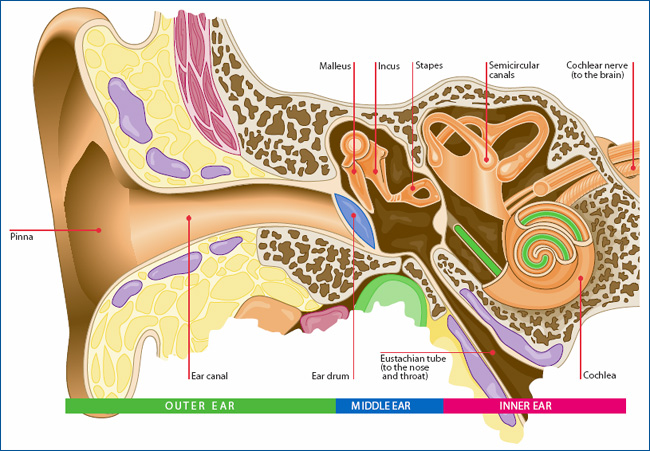How do we hear?
The ear is made up of three main sections:
• The Outer Ear
• The Middle Ear
• The Inner Ear
Sound waves from outside the ear are picked up by the pinna and sent into the ear canal whose job it is to increase the loudness of those sounds and direct them towards the inner ear. The sound waves hit the eardrum causing it to vibrate. The eardrum is very sensitive, the slightest air-pressure fluctuations will move it back and forth. The louder the sound the more the eardrum moves. It vibrates faster for higher pitched sounds than for lower pitched ones.
The sound vibrations from the eardrum move the three tiny bones called the ossicles. The first of these is the malleus. When the eardrum vibrates, it moves the malleus from side to side like a lever, which then strikes the incus, which pushes against the stapes, causing it to move. These bones form a bridge from the eardrum into the inner ear. The stapes is the smallest bone in the body. The ossicles increase and amplify the sound vibrations before sending them to the inner ear.Inner Ear
The cochlea resembles the circular shell of a snail, and houses a system of tubes, which are filled with fluid and lined with cells that have tiny hairs on top. These are called hair cells. The cochlea’s job is to take the physical vibrations from the middle ear and convert them into electrical signals. The stapes from the middle ear, acts as a piston, hitting the cochlea’s oval window and sending sound waves through the oval window, causing the fluid in the cochlea to move, setting the hair cells in motion. In turn, these hair cells transform the vibrations into electrical impulses that travel along the auditory nerve to the brain. The brain then interprets them and tells us what we are hearing.
Types of hearing loss
There are four types of hearing loss:
• Sensorineural
• Conductive
• Mixed
• Central
Sensorineural Hearing Loss
Is most often a permanent loss that is caused by abnormalities in the hair cells in the cochlea. Occasionally sensorineural hearing loss may involve the eighth cranial nerve. Medical interventions are rarely able to improve hearing.
Some common causes are:
• Ageing
• Injury
• Noise exposure
• Viral infections (such as measles or mumps)
• Ototoxic drugs (medications that damage hearing)
• Meningitis
• Stroke
• Meniere’s disease
• Acoustic tumors
• Heredity
Technologies such as hearing aids, cochlear implants, hybrid cochlear implants, and auditory brainstem implants can help reduce the effects of sensorineural hearing loss.
Conductive Hearing Loss
This occurs when there is a problem with the outer or middle ear that prevents sound from getting to the inner ear. It is more common in children and indigenous populations. Medical interventions and technologies are often used to treat conductive hearing loss.
Some common causes are:
• Infection of the ear canal or middle ear
• Fluid in the middle ear
• Perforation or scarring of the eardrum
• Wax build-up
• Dislocation of the ossicles (three middle-ear bones)
• Foreign objects in the ear canal
• Otosclerosis
• Growths or tumors
Technologies such as Hearing Aids, Bone Conduction Hearing Aids and Bone Anchored Hearing Devices (BAHA’s) can help reduce the effects of conductive hearing loss.
Mixed Hearing Loss
A mixed hearing loss occurs when both conductive and sensorineural hearing losses are present. The sensorineural component of the hearing loss is permanent, while the conductive component may be permanent or temporary. An example of a mixed hearing loss is when a person has an age-related hearing loss and a middle ear infection.
Central Hearing Loss
This is a very rare form of hearing loss. The problem occurs in the central auditory system in the brain. The outer, middle and inner ear deliver sound normally, however, the sound is not processed properly by the brain. Hearing aids do not help with this type of hearing loss.
Degree of Hearing Loss
The degree of hearing loss can range from mild to profound:
- Mild Hearing Loss
A person with a mild hearing loss can hear some speech sounds but softer sounds are difficult to hear. - Moderate Hearing Loss
A person with a moderate hearing loss may not be able to hear most speech when another person is talking at a normal level. - Moderately-Severe Hearing Loss
A person with a moderately-severe hearing loss will not hear speech at a normal level but can follow speech if it is spoken loudly. - Severe Hearing Loss
A person with a severe hearing loss will not hear speech when a person is talking at a normal level but can follow some speech if it is spoken loudly. - Profound Hearing Loss
A person with a profound hearing loss will not hear any speech, only very loud sounds.
Please note: with the use of lip reading (the use of clues such as facial expressions and gestures, as well as lip movements, to interpret what people are saying), people with hearing loss may still be able to understand some speech, even though they can’t hear all the speech sounds.
Information Courtesy of Ear Science Institute Australia www.earscience.org.au

